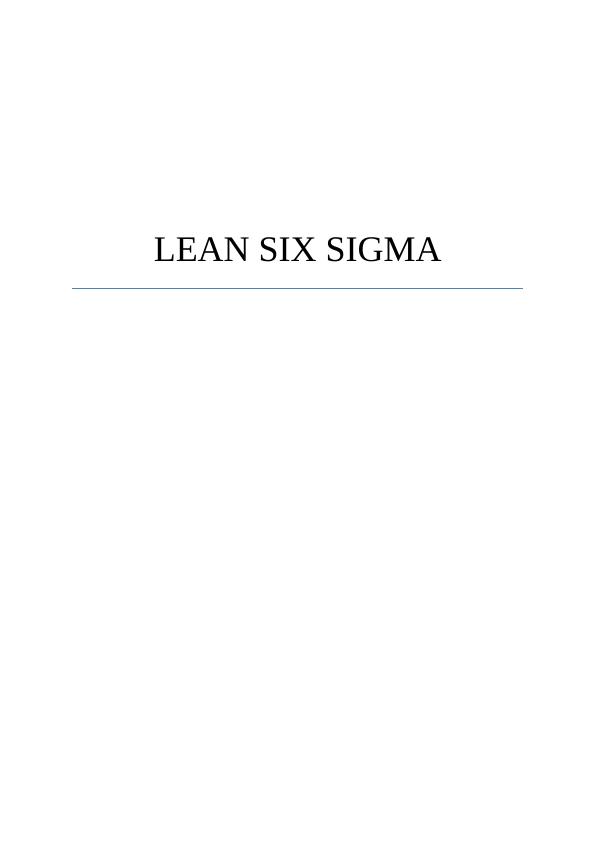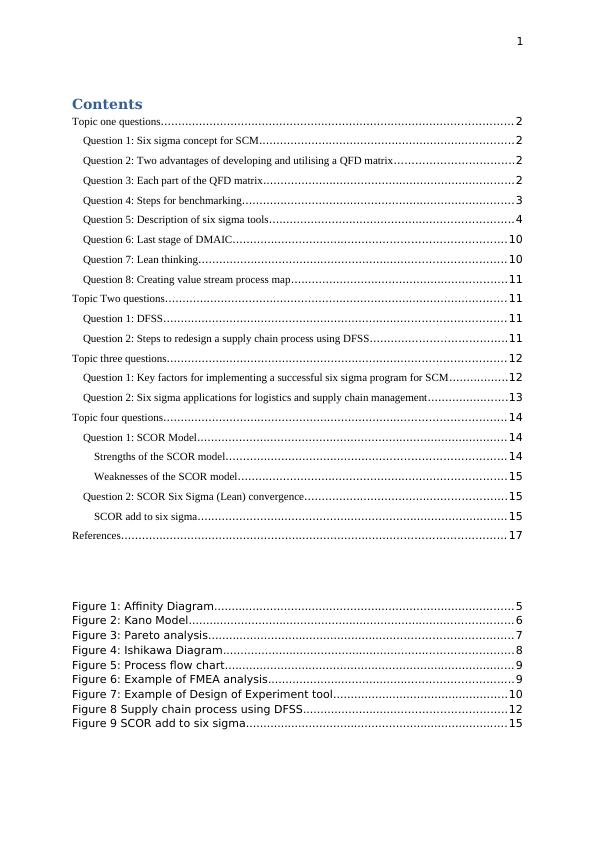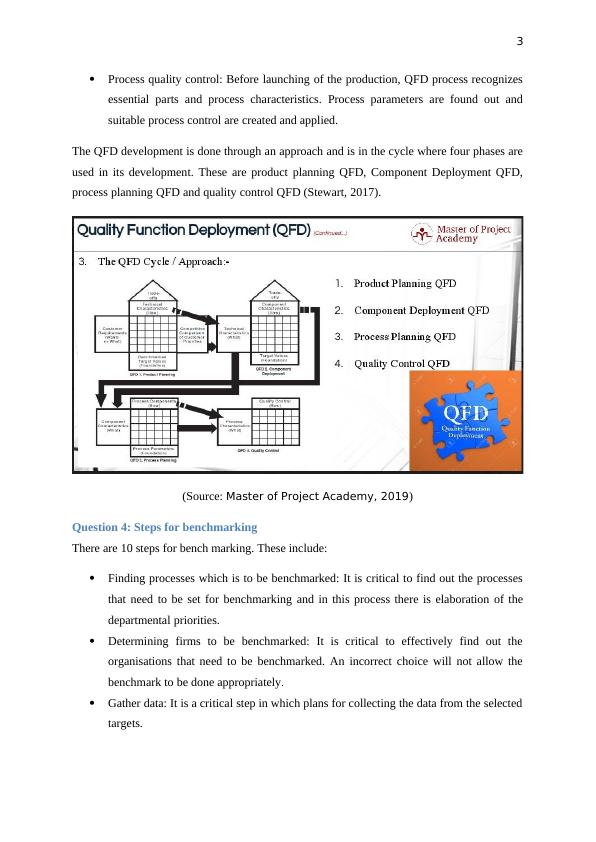Lean Six Sigma: Study Material with Solved Assignments and Essays
Added on 2022-11-12
20 Pages4183 Words210 Views
LEAN SIX SIGMA

1
Contents
Topic one questions..................................................................................................... 2
Question 1: Six sigma concept for SCM.........................................................................2
Question 2: Two advantages of developing and utilising a QFD matrix..................................2
Question 3: Each part of the QFD matrix........................................................................2
Question 4: Steps for benchmarking.............................................................................. 3
Question 5: Description of six sigma tools......................................................................4
Question 6: Last stage of DMAIC.............................................................................. 10
Question 7: Lean thinking........................................................................................ 10
Question 8: Creating value stream process map..............................................................11
Topic Two questions.................................................................................................. 11
Question 1: DFSS.................................................................................................. 11
Question 2: Steps to redesign a supply chain process using DFSS.......................................11
Topic three questions................................................................................................. 12
Question 1: Key factors for implementing a successful six sigma program for SCM.................12
Question 2: Six sigma applications for logistics and supply chain management.......................13
Topic four questions.................................................................................................. 14
Question 1: SCOR Model......................................................................................... 14
Strengths of the SCOR model................................................................................ 14
Weaknesses of the SCOR model............................................................................. 15
Question 2: SCOR Six Sigma (Lean) convergence..........................................................15
SCOR add to six sigma......................................................................................... 15
References.............................................................................................................. 17
Figure 1: Affinity Diagram...................................................................................... 5
Figure 2: Kano Model............................................................................................. 6
Figure 3: Pareto analysis....................................................................................... 7
Figure 4: Ishikawa Diagram................................................................................... 8
Figure 5: Process flow chart................................................................................... 9
Figure 6: Example of FMEA analysis......................................................................9
Figure 7: Example of Design of Experiment tool..................................................10
Figure 8 Supply chain process using DFSS..........................................................12
Figure 9 SCOR add to six sigma...........................................................................15
Contents
Topic one questions..................................................................................................... 2
Question 1: Six sigma concept for SCM.........................................................................2
Question 2: Two advantages of developing and utilising a QFD matrix..................................2
Question 3: Each part of the QFD matrix........................................................................2
Question 4: Steps for benchmarking.............................................................................. 3
Question 5: Description of six sigma tools......................................................................4
Question 6: Last stage of DMAIC.............................................................................. 10
Question 7: Lean thinking........................................................................................ 10
Question 8: Creating value stream process map..............................................................11
Topic Two questions.................................................................................................. 11
Question 1: DFSS.................................................................................................. 11
Question 2: Steps to redesign a supply chain process using DFSS.......................................11
Topic three questions................................................................................................. 12
Question 1: Key factors for implementing a successful six sigma program for SCM.................12
Question 2: Six sigma applications for logistics and supply chain management.......................13
Topic four questions.................................................................................................. 14
Question 1: SCOR Model......................................................................................... 14
Strengths of the SCOR model................................................................................ 14
Weaknesses of the SCOR model............................................................................. 15
Question 2: SCOR Six Sigma (Lean) convergence..........................................................15
SCOR add to six sigma......................................................................................... 15
References.............................................................................................................. 17
Figure 1: Affinity Diagram...................................................................................... 5
Figure 2: Kano Model............................................................................................. 6
Figure 3: Pareto analysis....................................................................................... 7
Figure 4: Ishikawa Diagram................................................................................... 8
Figure 5: Process flow chart................................................................................... 9
Figure 6: Example of FMEA analysis......................................................................9
Figure 7: Example of Design of Experiment tool..................................................10
Figure 8 Supply chain process using DFSS..........................................................12
Figure 9 SCOR add to six sigma...........................................................................15

2
Topic one questions
Question 1: Six sigma concept for SCM
Six sigma is utilised for making the process improvements which is essential in the
management of the operations and improving the quality of the overall processes such as
Supply Chain Management (Stanton, 2019). Six Sigma works on statistics hence it is an
effective tool that helps in predicting the future outcomes and also helps in bringing control
in the SCM which is critical for managing the demand and supply and hence bringing
efficiency in the overall process and decreasing the numbers of mistakes in the process.
Question 2: Two advantages of developing and utilising a QFD matrix
Different advantages of generating and utilising a QFD matrix has been showcased below:
Customer driven: Since the development and utilisation of the QFD is done on the
basis of the demands of the customers hence the overall development process is
dependent on the wants of the consumers.
Reduced development time: The likelihood of the design alters as the development of
this model emphasise on improvements that are done for satisfying the major
demands of the consumers. Higher attention towards requirements of the consumers
declines the threat that alteration will be needed lately in the life cycle of the project
(Quality-one, 2019).
Question 3: Each part of the QFD matrix
There are four parts of the QFD matrix. These include:
Product definition: This phase starts with accumulation of the demands of the
customers and translating the demands of the customers into the product specification.
Product development: In this part, the essential assemblies and parts are found out.
Essential product characteristics are cascaded down and translated to critical or key
parts and assembly specifications or characteristics.
Process development: In this part, processes related to manufacturing and assembly
are planned on the basis of specifications of product and components. There is
development of process flow and essential process characteristics are also found out
(Borysowich, 2019).
Topic one questions
Question 1: Six sigma concept for SCM
Six sigma is utilised for making the process improvements which is essential in the
management of the operations and improving the quality of the overall processes such as
Supply Chain Management (Stanton, 2019). Six Sigma works on statistics hence it is an
effective tool that helps in predicting the future outcomes and also helps in bringing control
in the SCM which is critical for managing the demand and supply and hence bringing
efficiency in the overall process and decreasing the numbers of mistakes in the process.
Question 2: Two advantages of developing and utilising a QFD matrix
Different advantages of generating and utilising a QFD matrix has been showcased below:
Customer driven: Since the development and utilisation of the QFD is done on the
basis of the demands of the customers hence the overall development process is
dependent on the wants of the consumers.
Reduced development time: The likelihood of the design alters as the development of
this model emphasise on improvements that are done for satisfying the major
demands of the consumers. Higher attention towards requirements of the consumers
declines the threat that alteration will be needed lately in the life cycle of the project
(Quality-one, 2019).
Question 3: Each part of the QFD matrix
There are four parts of the QFD matrix. These include:
Product definition: This phase starts with accumulation of the demands of the
customers and translating the demands of the customers into the product specification.
Product development: In this part, the essential assemblies and parts are found out.
Essential product characteristics are cascaded down and translated to critical or key
parts and assembly specifications or characteristics.
Process development: In this part, processes related to manufacturing and assembly
are planned on the basis of specifications of product and components. There is
development of process flow and essential process characteristics are also found out
(Borysowich, 2019).

3
Process quality control: Before launching of the production, QFD process recognizes
essential parts and process characteristics. Process parameters are found out and
suitable process control are created and applied.
The QFD development is done through an approach and is in the cycle where four phases are
used in its development. These are product planning QFD, Component Deployment QFD,
process planning QFD and quality control QFD (Stewart, 2017).
(Source: Master of Project Academy, 2019)
Question 4: Steps for benchmarking
There are 10 steps for bench marking. These include:
Finding processes which is to be benchmarked: It is critical to find out the processes
that need to be set for benchmarking and in this process there is elaboration of the
departmental priorities.
Determining firms to be benchmarked: It is critical to effectively find out the
organisations that need to be benchmarked. An incorrect choice will not allow the
benchmark to be done appropriately.
Gather data: It is a critical step in which plans for collecting the data from the selected
targets.
Process quality control: Before launching of the production, QFD process recognizes
essential parts and process characteristics. Process parameters are found out and
suitable process control are created and applied.
The QFD development is done through an approach and is in the cycle where four phases are
used in its development. These are product planning QFD, Component Deployment QFD,
process planning QFD and quality control QFD (Stewart, 2017).
(Source: Master of Project Academy, 2019)
Question 4: Steps for benchmarking
There are 10 steps for bench marking. These include:
Finding processes which is to be benchmarked: It is critical to find out the processes
that need to be set for benchmarking and in this process there is elaboration of the
departmental priorities.
Determining firms to be benchmarked: It is critical to effectively find out the
organisations that need to be benchmarked. An incorrect choice will not allow the
benchmark to be done appropriately.
Gather data: It is a critical step in which plans for collecting the data from the selected
targets.

End of preview
Want to access all the pages? Upload your documents or become a member.
Related Documents
Six Sigma for Supply Chain Management: Tools, Techniques and Applicationslg...
|15
|4499
|311
Supply Chain Operating Reference Modellg...
|73
|16380
|36
Lean Six Sigma in Industrieslg...
|18
|6773
|460
Implementation of Strategic Tools in Operations Managementlg...
|11
|2735
|84
Research Aim and Objectives Supply Chainlg...
|15
|2745
|25
Application of Key Supply Chain Concepts, Principles and Processeslg...
|43
|9383
|189